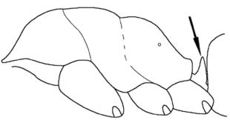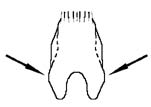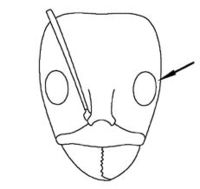Dolichoderinae of the southwestern Australian Botanical Province
There are numerous Dolichoderinae genera in the SWBP for which there are relatively few representative species present. Keys or in some cases a couplet for these genera are given below. The contents of this page is based on: Heterick, B. E. 2009a. A guide to the ants of South-western Australia. Records of the Western Australian Museum, Supplement 76: 1-206. Part 1.
You may also be interested in
- Australia
- SWBP
- Dolichoderinae
- Key to the Dolichoderinae genera of the southwestern Australian Botanical Province
- Key to Dolichoderus of the southwestern Australian Botanical Province
- Key to Iridomyrmex of the southwestern Australian Botanical Province
Anonychomyrma
1An
- In full-face view, head capsule about as long as wide, vertex shallowly concave (Figure 130); small setae constituting pubescence almost semi-erect; mesonotum not prominent (terrestrial) . . . . . Anonychomyrma itinerans perthensis
- In full-face view, if head capsule as long as wide, then vertex deeply concave (Figures 131, 132); small setae constituting pubescence appressed or weakly decumbent; mesonotum often prominent (arboreal) . . . . . 2An
2An
return to couplet #1An
- Erect setae absent from sides of head capsule; vertex deeply concave; head capsule as long as wide (Figure 131); mandibles usually brown or orange, contrasting with darker head . . . . . Anonychomyrma nitidiceps
- Erect setae present on sides of head capsule; vertex shallowly concave; head capsule distinctly longer than wide; mandibles often black or dark brown, concolorous with head (Figure 132) . . . . . Anonychomyrma sp. JDM 835
Arnoldius
Arnoldius scissor (Crawley) was described from a queen, and so the taxon is not formally recognized in this key to workers.
- Eye larger, eye width > greatest width of antennal scape; brown species . . . . . Arnoldius sp. JDM 433
- Eye smaller, eye width ≤ greatest width of antennal scape; yellowish species . . . . . Arnoldius sp. JDM 170
Doleromyrma
- Node prominent, rising well above the articulation of the peduncle with the propodeum (Figure 133a); in full-face view head usually not distinctly rectangular, without evenly convex sides above and below midpoint of head (Figure 133b) . . . . . Doleromyrma darwiniana fida
- Node indistinct, Tapinoma-like, barely rising above the articulation of the peduncle with the propodeum (Figure 134a); in full-face view, head typically strongly rectangular, the sides of the head evenly convex above and below the midpoint (Figure 134b) . . . . . Doleromyrma rottnestensis
Froggattella
- Viewed dorsally, propodeal spines thick, laterally convex, not distally digitate (Figure 145); in full-face view, head capsule noticeably longitudinally striate between and around frontal carinae, smooth and shining posteriad . . . . . Froggattella latispina
- Viewed dorsally, propodeal spines tending to straight distally, digitate in appearance (Figure 146); in full-face view, head capsule uniformly weakly shining, with superficial micoreticulation evident in some lights . . . . . Froggattella kirbii
Ochetellus
- Body chocolate to black, appendages dark brown . . . . . Ochetellus glaber group sp. JDM 19
- Head, mesosoma, node and appendages orange or red; legs light brown to brown, gaster dark . . . . . Ochetellus sp. JDM 851
Papyrius
- Vertex of head capsule, first gastral tergite and node with erect setae; large species (HW 1 mm.> . . . . . Papyrius sp. JDM 666
- Vertex of head capsule, first gastral tergite and (usually) node lacking erect setae; smaller species (HW ≤ 1 mm) . . . . . Papyrius nitidus
Tapinoma
1T
- Foreparts dark brown, strongly contrasting with pale gaster and appendages . . . . . Tapinoma melanocephalum
- Foreparts, gaster and appendages more-or-less concolorous . . . . . 2T
2T
return to couplet #1T
- Eye large, eye length ≈ 1/3 length of headcccapsule (Figure 184) . . . . . Tapinoma sp. JDM 981
- Eye smaller, eye length ≤ 1/4 length of head capsule (Figure 185) . . . . . Tapinoma sp. JDM 78










